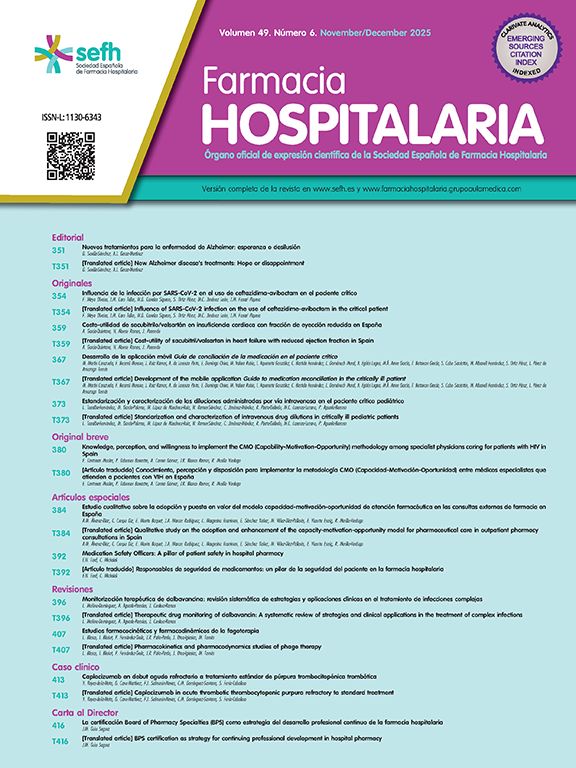Acquired/autoimmune thrombotic thrombocytopenic purpura (iTTP) is characterized by the presence of antibodies against ADAMTS13. Deficiency in this metalloprotease prevents cleavage of von Willebrand factor (VWF) resulting in increased platelet adhesion and a higher risk for microthrombosis.1,2 Manifestations of iTTP include hemorrhage, hemolytic anemia, schistocytosis, tissue ischemia, neurological manifestations, consumptive thrombocytopenia, and elevated lactate dehydrogenase (LDH). Diagnosis of iTTP is established upon confirmation of an ADAMTS13 activity <10%.3
The standard of care in acute iTTP includes plasmapheresis with concomitant corticosteroids and rituximab.1 When conventional treatment is ineffective in acute iTTP (nearly 20% of cases), it is defined as refractory iTTP.4 In Spain, caplacizumab is publicly Valorar reimbursed in this clinical setting.5 Caplacizumab is a humanized bivalent nanobody with activity in the A1 domain of von Willebrand Factor (vWF) that interferes with the interaction of vWF with the glycoprotein complex Ib-V-IX of platelets, thereby preventing thrombosis.
We report the case of a successfully treated young female patient with severe refractory iTTP. This case report demonstrates the real-life utility of caplacizumab after a 1.5-year follow-up and highlights the relevance of managing iTTP from a multidisciplinary approach.
Clinical caseA 24-year-old patient with Sudeck syndrome using transdermal norelgestromin/ethinyl estradiol patches on a regular basis. The patient was admitted to our emergency department in June 2023 with a three-week history of malaise; increased bowel movements without pathological products; abdominal pain; moderate cephalea; asthenia; 38 °C; petechias in the limbs and face; and hematomas in the ankles. Her vital signs were within normal limits, and nothing abnormal was detected upon examination.
Laboratory test results included hemoglobin 5.1 g/dl; reticulocytes 6.58%, LDH 1040 U/l, 27,000 platelets/μl; schistocytes 15%, D-dimer 7181 ng/ml; and a normal coagulation profile.
The patient was admitted to the Intensive Care Unit (ICU) for follow-up by the Unit of Hematology and the Hospital Pharmacy, with an established diagnosis of thrombotic microangiopathy and high suspicion of iTTP. A blood sample was sent to measure ADAMTS13 activity. Daily plasmapheresis of one plasma volume was initiated along with methylprednisolone at 1 mg/kg/day. Additionally, two units of packed RBCs were infused.
During hospitalization, the platelet count progressively increased. Rituximab at 570 mg/week was initiated (375 mg/m2/week for 4 weeks) on day 6. In the following days, platelet count decreased concurrently with the onset of hemorrhagic (gingivorrhagia, metrorrhagia) and neurological (severe headache, diplopia) symptoms. On day 7, the results of ADAMTS13 activity at admission were reported (0.00%), confirming the diagnosis of iTPP. Following a literature search, the Hospital Pharmacy and the Unit of Hematology decided to initiate caplacizumab therapy. Prior to plasmapheresis, a first dose of caplacizumab 10 mg was administered; thereafter, caplacizumab 10 mg was administered subcutaneously once daily.
Following the initiation of caplacizumab therapy, analytical and clinical parameters improved significantly. ADAMTS13 activity reached 49.85% on day 13. Serology confirmed elevated titers of anti-ADAMTS13 antibodies.
On day 23, the patient was discharged from the ICU and transferred to the Internal Medicine Ward. Plasma exchange and rituximab were discontinued on day 29. The patient was discharged from hospital on day 38. Progressive corticosteroid withdrawal was initiated on day 30 and completed on day 71. Fig. 1 provides details of the treatment approach, platelet count, and ADAMTS13 activity during hospitalization.
The effectiveness and safety of caplacizumab were monitored by the Hospital Pharmacy through routine validation and joint follow-up. The Hospital Pharmacy was also involved in the validation of the other treatments (plasmapheresis and corticosteroids). Upon discharge, follow-up was conducted and the family was instructed and trained in the proper administration of the treatment.
The Unit of Hematology conducted weekly evaluations, which were spaced to monthly intervals following clinical improvement. The treatment was dispensed by the Hospital Pharmacy until day 59 from admission (30 days after plasmapheresis completion). During the follow-up period, the clinical and analytical evolution of the patient was favorable.
Platelet count increased to 290,000 platelets/μl with an ADAMTS13 activity of 61.16% one month after caplacizumab therapy was completed. At 6 months, ADAMTS13 activity according to the last test was 77.00%. During the 1.5-year follow-up period following the completion of caplacizumab therapy, the patient experienced episodes of migraine, but not thromboembolism or hemorrhage. Platelet count was last tested in November 2024, with a result of 198,000 platelets/μl. The patient is currently undergoing testing for Sjögren's syndrome and connective tissue disease prompted by the presence of xerostomia and positive antinuclear antibodies (ANAs).
DiscussionThe effectiveness of caplacizumab was demonstrated in the TITAN (phase II) and HERCULES (phase III) clinical trials, which compared caplacizumab versus placebo with therapeutic plasma exchange and immunosuppression.4 Later, a systematic review and meta-analysis that included the aforementioned clinical trials and three observational studies confirmed that caplacizumab significantly reduces the risk of exacerbation, relapse, platelet recovery time, duration of plasmapheresis, and length of hospital stay, with a significantly higher risk for hemorrhage, as compared to placebo. Notably, no differences were observed in mortality.1
In the case reported here, caplacizumab was used as a rescue treatment for severe iPTT refractory to conventional treatment. Less than four days after initiating treatment; significant improvements were observed in platelet count; clinical symptoms; markers of organ damage; laboratory indicators of hemolysis; and ADAMTS13 activity The management and clinical evolution of this case are consistent with those described in previous case reports and similar studies in an older population.1,6,7 This case report contributes to the optimization of caplacizumab therapy, supports its utility in managing iTTP, and demonstrates its effectiveness over the standard of care.
One year and a half after completion of caplacizumab therapy, the patient had not experienced any episode of thromboembolism, which demonstrates the role of this therapy in preventing relapse. To the best of our knowledge, this is the first long-term study on the use of caplacizumab in a young patient with iTTP.
This case report contributes to the existing body of knowledge on the long-term safety and effectiveness of caplacizumab in highly complex clinical scenarios. These findings will help optimize the management of young patients, a crucial step forward considering the high cost of the treatment.
Presentation in conferencesA preliminary report of this clinical case was presented in the 69º National Congress of the Spanish Society of Hospital Pharmacy (SEFH) held on October 17–19, 2024.
Authorship responsibility and copyright transferAll authors accept full responsibility as defined by the International Committee of Medical Journal Editors.
In the event of publication, the authors hereby exclusively transfer the rights of reproduction, distribution, translation, and public communication (by any means or through any sound, audiovisual, or electronic medium) of our work to Farmacia Hospitalaria and the SEFH. To this end, a copyright transfer agreement will be signed at the time of submission through the online manuscript management system.
CRediT authorship contribution statementYeray Reyes de la Mata: Writing – review & editing, Writing – original draft, Visualization, Supervision, Software, Resources, Project administration, Methodology, Investigation, Formal analysis, Data curation, Conceptualization. Gala Cano Martínez: Writing – review & editing, Writing – original draft, Visualization, Validation, Supervision, Methodology, Investigation, Data curation, Conceptualization. Francisco Javier Salmerón Navas: Writing – original draft, Validation, Supervision, Methodology, Investigation, Data curation, Conceptualization. Carmen María Domínguez Santana: Writing – review & editing, Visualization, Validation, Project administration, Methodology, Conceptualization. Silvia Fenix-Caballero: Writing – review & editing, Visualization, Validation, Supervision, Project administration, Methodology, Investigation.
Informed consentInformed consent was obtained from the patient.
FundingThis study did not receive any funding.
The authors declare no conflict of interest.








